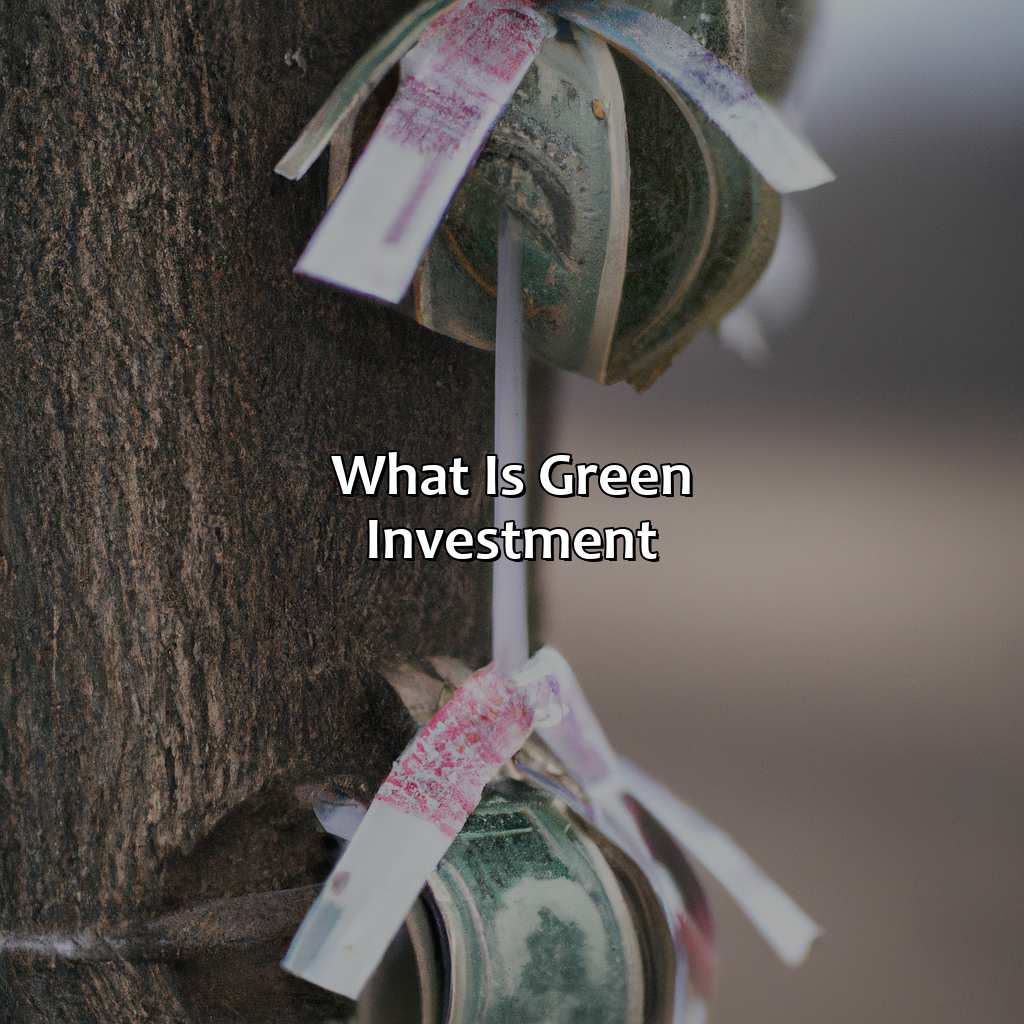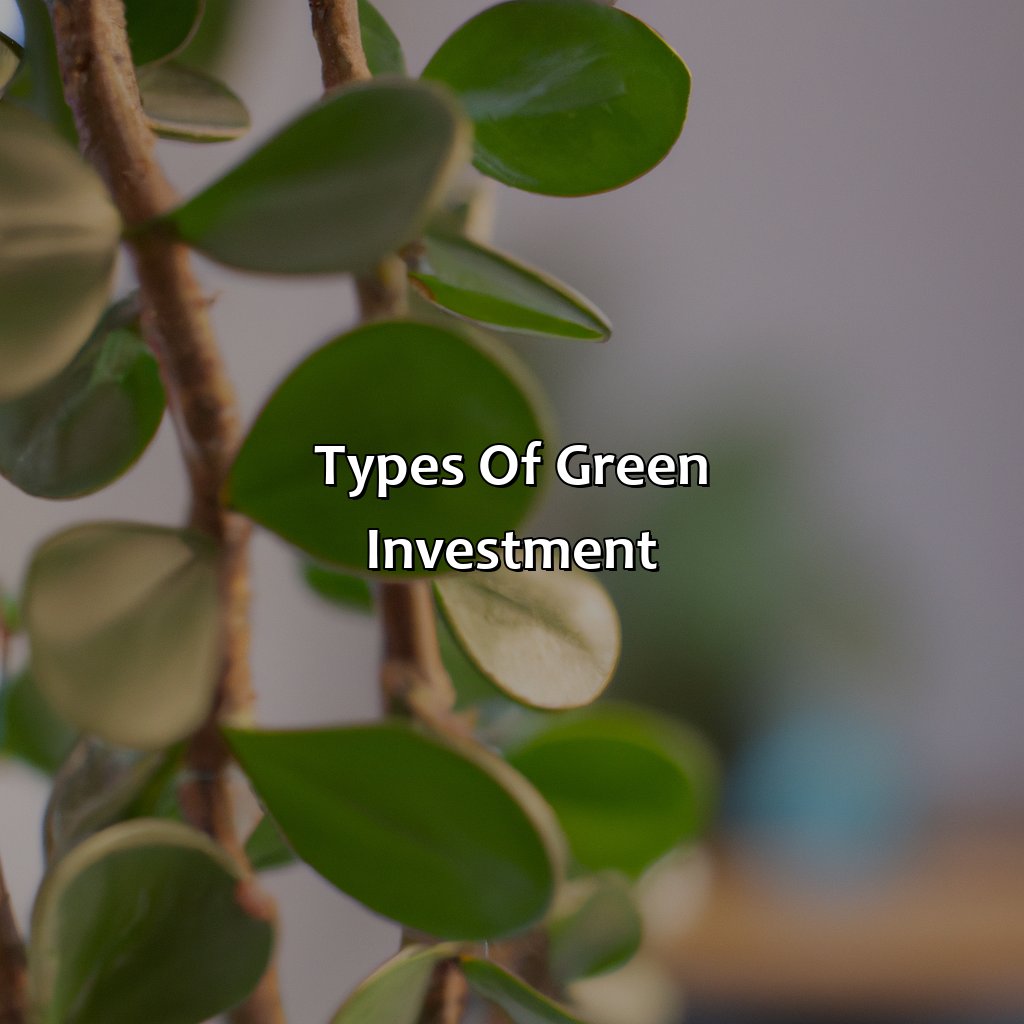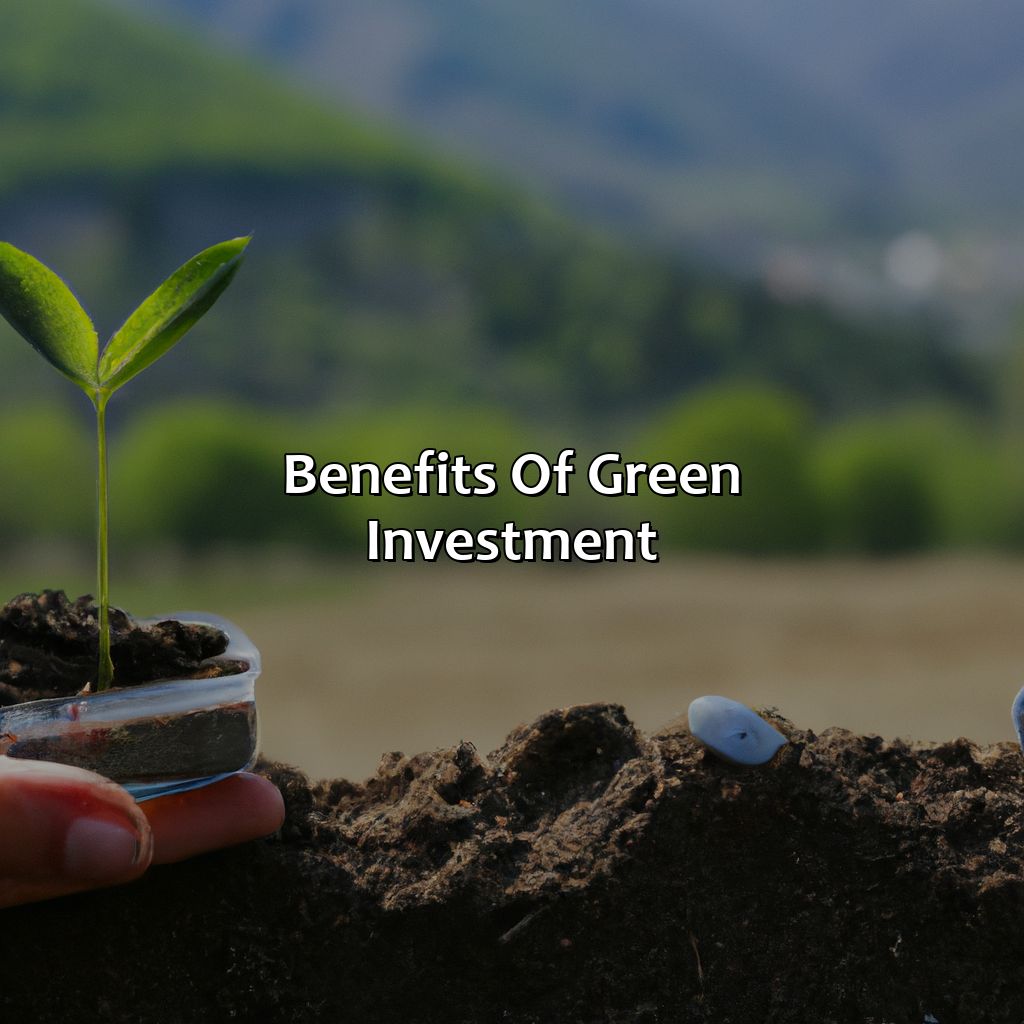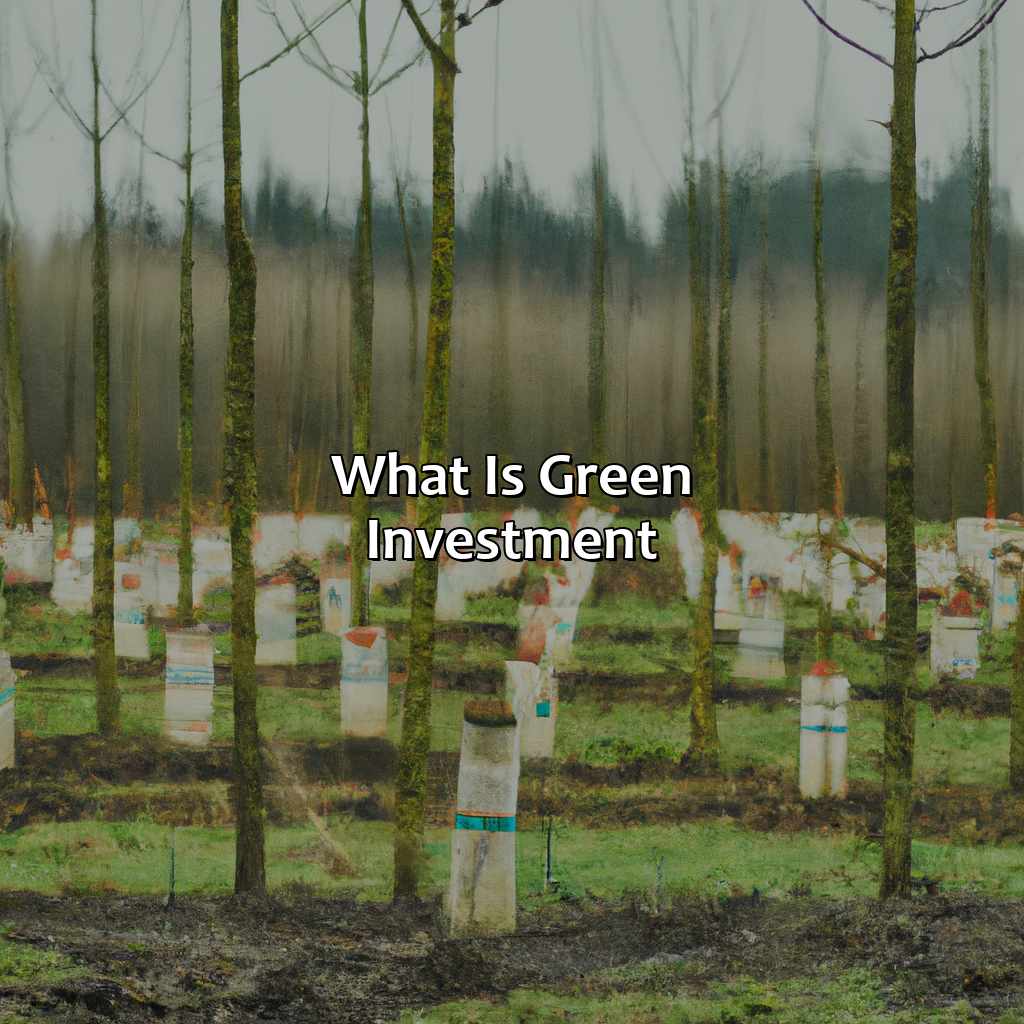What Is Green Investment?
Key Takeaway:
- Green investment refers to investments made in projects that promote sustainability and environmental responsibility, such as renewable energy, sustainable agriculture, green buildings, and clean transportation.
- Green investment is important because it can help reduce greenhouse gas emissions, mitigate climate change, and promote a more sustainable and equitable society.
- The benefits of green investment include environmental, economic, and social benefits. Green investment can create jobs, reduce energy costs, and improve public health and well-being.
Are you looking to make an ethical and environmentally-friendly investment? Discover the meaning of green investment and how it can benefit you and the planet. You will learn how to invest responsibly and work towards a sustainable future.
What is Green Investment?
To comprehend green investment and its consequence, we must first define it. Knowing the definition will provide the context necessary. We then can discuss its importance, which will demonstrate the potential for sustainable and profitable solutions.

Image credits: retiregenz.com by Adam Arnold
Definition of Green Investment
Green investment refers to the act of investing in activities or projects that are environmentally sustainable and have a positive impact on the planet. This type of investment focuses on financing and promoting activities that help to reduce environmental damage, mitigate climate change, and create a more sustainable future.
Investing in renewable energy sources such as wind, solar or hydropower, as well as clean technologies, green buildings and agriculture, are some examples of green investments. The aim is to support businesses that prioritize environmental sustainability by providing them with capital they can use for growth and innovation.
Green investments offer significant benefits beyond just financial returns. They contribute to social well-being by creating new jobs in emerging sectors, reducing pollution risks, increasing the adoption of clean energy sources and improving public health. In addition, investors who embrace these opportunities are well-positioned to capitalize on emerging markets, brand differentiation and competitive advantage.
Don’t miss out on the potential benefits of green investment. By including it in your investment portfolio, you not only stand to gain financially but also become an advocate for a better environment for future generations to come. Green investment may not make you rich, but it’s the only investment where everyone wins – except for the coal industry, but who cares about them?
Importance of Green Investment
Investing in Green Initiatives – A Vital Global Requirement
Green investment is becoming increasingly essential globally due to the alarming rate of environmental degradation. The world population is growing, leading to increased demand for energy and resources. However, these natural resources are finite, and using non-renewable energy sources harms our planet in various ways. Hence, investing in green initiatives is vital to ensure a sustainable future.
Green investments play an innovative role in utilizing renewable energy sources to reduce carbon emissions and meet increasing demands for clean energy. Such initiatives also aim at developing sustainable ways of production that have minimal environmental impact, thus reducing pollutants’ release into the environment.
Investing in green initiatives has additional benefits like creating employment opportunities and boosting economic growth through technological innovation. Given the critical role this kind of investment plays not only for the environment but also for economic sustainability, governments should provide incentives such as tax exemptions and subsidies to encourage more investors.
Investing in sustainable energy sources is the new hippies don’t exist, but I still want to save the planet.
Types of Green Investment
To find innovative ways to invest in eco-friendly projects, take a look at the “Types of Green Investment” section. This includes subsections such as:
- Renewable Energy
- Sustainable Agriculture
- Green Building
- Clean Transportation Investments
Each one allows you to back eco-friendly initiatives in different sectors. We’ll explain them in more detail in the coming subsections.

Image credits: retiregenz.com by James Washington
Renewable Energy Investments
Investment in environmentally friendly alternatives like wind or solar power is known as sustainable or “clean energy” investments. Renewable Energy Investments involve providing financial support to eco-friendly and sustainable projects that aid in reducing domestic, commercial, and industrial carbon footprints. By investing in renewable energy sources, we can help create a greener world while also earning profits for sustainable development.
Renewable projects include clean energy transmission utilities, renewable fuel facilities and technology companies developing new green products. Most Renewable Energy Investments are made into private ventures that specialize in the production of green energy technologies, construction of clean energy infrastructure, and related services.
Investing in this sector can yield long-term benefits with minimal risk. It’s also highly scalable for institutional investors seeking to channel large amounts of capital into the sector.
Don’t miss out on the opportunity to make a positive impact on the environment while making meaningful returns on your investment today! Investing in sustainable agriculture is like watering your plants with champagne – it’s good for the environment and good for your wallet.
Sustainable Agriculture Investments
Investing in environmentally-friendly agriculture is an ideal way to contribute to sustainable development. Many investment opportunities are available, including sustainable crop production, regenerative agriculture, and organic farming. These investments aim to reduce negative impacts on the environment while increasing profits.
Sustainable agriculture investments also include land conservation and reforestation projects that contribute to carbon sequestration. Investors can support sustainable forestry practices that promote biodiversity and increase the ecological resilience of these areas.
Moreover, sustainable agriculture investments lead to a decrease in greenhouse gas emissions while promoting healthy soil management practices. Sustainable farming methods foster a balance between economic profitability and environmental stewardship.
By investing in sustainable agriculture, individuals can make meaningful contributions towards creating a more equitable and environmentally conscious future. Don’t miss out on an opportunity to make positive changes while securing long-term financial gains.
Green buildings may be eco-friendly, but they also make for great insulation against zombies in the event of an apocalypse.
Green Building Investments
Investing in environmentally responsible building projects is a wise decision for those who want to contribute to sustainable development. Choosing energy-efficient materials, reducing water usage and implementing waste management strategies are some of the ways to make real estate investments green. Optimizing energy use in buildings with the latest technology can reduce carbon footprint and operating costs. Renewable power sources like solar panels or wind turbines also play a significant role in making buildings efficient and eco-friendly.
Green building investments require careful planning, research, and new technologies to achieve the environmental goals while maintaining profitability. Sustainable design considerations, such as natural light, ventilation systems, insulation materials, and water conservation measures are crucial when building green structures. Investing in high-performance buildings optimizes long-term benefits by providing better indoor air quality and creating healthier environments for occupants.
Pro Tip: Collaborating with local governments or non-profit organizations that promote sustainability could provide opportunities for additional funding resources towards your green building investments.
Investing in clean transportation is not just eco-friendly, it’s also a great way to avoid getting stuck in traffic with people who haven’t heard of deodorant.
Clean Transportation Investments
Investing in eco-friendly transportation options falls under sustainable transportation investments. This type of investment focuses on promoting cleaner modes of transport, reducing emissions and improving air quality. Examples of clean transportation investment include:
- electric cars and bikes
- renewable fuel-powered buses and trains
- bike-sharing schemes
- carpooling initiatives, and alternative fuel stations.
Clean Transportation Investments seek to provide an environmentally-friendly option for commuters while reducing harmful emissions that contribute to climate change. These types of projects aim to promote the use of renewable energy sources such as solar energy to power electric cars and buses. Additionally, smart infrastructure technologies are utilized to optimize traffic flow and minimize travel time for drivers.
Green Investment in the transport sector is an excellent way to reduce carbon emissions since transportation is a significant contributor to greenhouse gas (GHG) emissions globally. Investing in clean transportation contributes positively to the fight against climate change by reducing air pollution levels while providing reliable Eco-friendly Transportation.
Investing in clean transport options can be expensive; hence collaboration between governments and public-private partnerships are essential for green investment projects’ success. Investors can also consider investing through green bonds or national transit programs that focus on greener alternatives for vehicles instead of fossil fuel-powered ones. Therefore, Clean Transportation Investments move humanity closer towards a low-carbon future while benefiting both individual investors and society as a whole.
Going green not only benefits the environment, but also your wallet – it’s a win-win situation for those who want to invest and make a positive impact.
Benefits of Green Investment
Discover the advantages of green investment! Focus on its environmental, economic, and social aspects. It brings positive outcomes – from more value and meaning to financial returns. Invest green and see the benefits!

Image credits: retiregenz.com by Harry Woodhock
Environmental Benefits
Investing in environmentally friendly projects provides significant advantages for our planet’s ecosystem. Green investment is proven to reduce greenhouse gas emissions, decrease pollution, and protect the earth’s natural resources. These benefits result in a healthier environment for both present and future generations.
Furthermore, green investment reduces energy consumption by promoting renewable energy sources like solar, wind, and hydro power. This shift decreases reliance on fossil fuels and protects the natural resources used to produce them. Investing in eco-friendly projects also has a positive impact on biodiversity as it reduces habitat destruction and loss of species.
Pro Tip: Investing ethically not only helps the environment but can also provide a competitive financial return on investment in the long term.
Investing in green initiatives is not just environmentally responsible, it’s also economically sensible – it’s like getting a tax break for doing the right thing.
Economic Benefits
Investments in eco-friendly projects can generate economic gains, also known as Sustainable Financial Benefits (SFBs). These benefits include fiscal profitability, job creation, and a competitive advantage. Green investments are those made in renewable energy sources, water conservation projects, and sustainable infrastructures. Such investments have the potential to help reduce environmental degradation while providing attractive returns on investment.
SFBs provide long-term financial security and prevent future obligations to fund environmental restoration. A green investment economy is likely to attract businesses focused on sustainability, such as electric vehicle manufacturers or recycling companies offering employment opportunities that meet the community’s ecological needs. In addition, SFBs can reduce healthcare costs associated with air pollution and improve the population’s overall health status.
Studies show that an approximate annual savings of $13 billion can be generated by improving building energy efficiency alone in the US, where nearly 40% of energy consumption takes place in residences. With diligent efforts towards investing in green technologies and infrastructure can enable significant savings on expensive energy bills while simultaneously reducing carbon emissions.
As per reports of The United Nations Environment Programme Finance Initiative (UNEP FI), 2020- Apart from being profitable for investors and contributing towards combating climate change through renewable energy innovations – ‘Green Investment’ is imperative for our planet’s sustainability now more than ever before.
(Source: UNEP FI report 2020)
Investing in green initiatives not only helps the environment, but also makes you look like a cool, socially conscious human being – way better than being known as the guy who constantly forgets his reusable bag at the grocery store.
Social Benefits
The positive impact that green investment bears on the society and community is highly notable. Besides catalyzing economic growth, green investment has a profound effect on social progress by creating job opportunities, promoting ethical practices, and uplifting living standards. Green investment encourages companies to operate responsibly while minimizing their environmental footprints. This ultimately creates socially responsible firms that prioritize the needs of people while safeguarding the planet for future generations.
Moreover, green investments promote environmental justice by mitigating pollution and generating renewable energy sources in marginalized communities. In addition to this, investing in environmentally friendly infrastructure enhances access to basic amenities such as clean water and sanitation facilities. These improvements significantly benefit vulnerable populations that have been historically denied these resources.
Green investment presents an opportunity for investors to earn a return on their investments while positively impacting the environment and society. When businesses adopt sustainable practices, they help create an ecosystem of responsible corporate culture that attracts socially conscious consumers who demand transparency in production processes. This increased awareness can boost brand image and drive company profits.
Pro Tip: Be mindful of investing in companies that are truly committed to sustainability rather than using it as a mere marketing tool. Thoroughly investigate a company’s policies and track record before investing your money in them.
Green investment may have its risks and challenges, but at least you’re not investing in coal mines and contributing to global warming – that’s a hot mess.
Risks and Challenges
To get the scoop on risks and challenges of green investment, check out the four sub-sections:
- Market Risk
- Regulatory Risk
- Technology Risk
- Financial Risk
All of these can stop investors from getting into the green investment market. Knowing these risks is key to making wise investment choices.

Image credits: retiregenz.com by Harry Woodhock
Market Risk
With investment, there are always market uncertainties that need to be considered. One of these is the potential for market fluctuations and volatility, where changes in economic conditions can impact the value of green investments. Even if an investment appears stable today, a sudden shift could alter its trajectory and lead to significant losses.
It’s important to recognize that green investments pose unique market risks because they’re often tied to emerging or niche industries, which can be more susceptible to market disruption. This type of risk may manifest in factors such as regulatory changes, policy shifts, and changes in consumer sentiment towards sustainable practices.
To mitigate these risks, it’s essential to conduct thorough research into potential investments and monitor industry trends closely. Additionally, diverse portfolios can help offset any losses caused by single-market disruptions.
Green investing has gained momentum worldwide, with funds like Calvert Global Energy Solutions reporting returns up to 54% since its inception.
Source: Calvert funds heat up as clean energy gains steam. Regulatory risk is like a game of chess – you never know when the government will checkmate your green investment.
Regulatory Risk
When discussing investments in the green industry, one must be aware of the potential risks associated with regulatory guidelines. Rules and regulations can change quickly, leaving investors exposed to unexpected costs and financial losses. This is particularly true for green investments as countries set new goals and standards that investors must adhere to.
Additionally, there may be limits on permits, licenses, or subsidies for green projects. Countries are not obligated to support sustainable initiatives, which leaves green investors vulnerable. Consequently, regulatory risk is crucial to be taken into account when considering any sustainable investment to minimize potential losses.
Another aspect of regulatory risk is that different countries have varying rules and regulations regarding environmental investments. Green investors may face challenges in navigating unfamiliar legal systems while continuing to develop a project under strict guidelines. Legal disputes or extended consultation processes can lead to project delays or abandonment if the regulations obstructed certain business objectives.
Furthermore, an example of regulatory risk arose in 2020 when a Brazilian firm’s mining project was canceled due to climate concerns raised by regulators. Investors lost $2 billion due to inadequate planning for meeting environmental standards and discontinuation of operations. The failure of this project suggests how important it is that companies take regulatory compliance seriously while investing in eco-friendly initiatives.
Using outdated technology in green investments is like trying to win a marathon with a horse and carriage.
Technology Risk
Investments in green technology have inherent risks and challenges. These may include the use of untested or experimental technologies, which may not perform as expected or fail miserably in the market. Additionally, these types of investments are often capital intensive, requiring large amounts of resources to fund research and development projects. As a result, investors must conduct thorough due diligence before investing to minimize their risk exposure.
However, despite the potential pitfalls, investing in green technology is vital for meeting sustainability goals. From wind turbines to solar cells, green energy technology can significantly reduce our reliance on non-renewable energy sources and protect the environment from emissions-related harm.
To ensure successful investment results, investors should follow industry trends and analyze market data from reputable sources like Bloomberg New Energy Finance. By staying up-to-date on technological advancements and regulatory changes within the sector, investors can more effectively evaluate potential investment opportunities.
A recent study by McKinsey & Company found that sustained green investment
could save up to $190 billion in energy costs by 2030 while creating millions of new jobs across all sectors of the global economy. This underscores the importance and potential benefits of environmentally friendly investment strategies.
Investing in green energy is like playing Russian roulette, but instead of bullets, you have to dodge bankruptcy.
Financial Risk
Green Investment’s Financial Exposure
Green investment is exposed to financial risk. The financial risks involved in green investment refer to the possibility of losing money or not achieving the expected financial returns from green projects. These risks are prevalent across all industries that involve financing sustainable environmental initiatives.
One of the significant financial risks in green investments is regulatory change that can affect the returns on investment. Changes in regulations regarding taxation, subsidies, and tariffs can impact the market competitiveness of green products, and as a result, affect investors’ returns.
Another prominent risk faced by investors in green investments is technology disruption. New technologies or advancements can make existing technologies obsolete quickly. Therefore, adopting and investing in old technologies can lead to significant losses for investors.
Investors need credible data sources such as GreenBiz, Hogan Lovells, Bloomberg Law for accurate information on new developments in policy and technology relating to green investments.
True Fact- In September 2020, David Attenborough launched a new global online platform called ‘Voice for the Planet’. It aims to encourage individuals worldwide to take action and put pressure on world leaders about environmental issues – GreenBiz
Green may be the color of money, but investing in eco-friendly projects can also help save the planet – talk about a win-win!
How to Invest in Green Projects
Investment in green projects with sustainability in mind can be done in various ways. These are Green Investment Funds, Direct Investment in Green Companies, Crowdfunding and Green Bonds. Each have their own advantages, from diversification to direct ownership. This idea has grown as more people become aware of the environment.

Image credits: retiregenz.com by Yuval Duncun
Green Investment Funds
Investment schemes catering to environmentally-friendly renewable energy projects are known as Eco-Investment funds. These funds primarily invest in businesses involved in the production and distribution of solar, wind, and other green technologies. They may also involve companies looking to mitigate their carbon footprint through promoting sustainable practices.
Moreover, eco-investment funds’ portfolio contains stocks of companies renowned for unparalleled environmental performance. Investing in these funds helps promote sustainability while securing good returns on investment opportunities tailored for environmental enthusiasts and investors alike.
Investors should conduct thorough research and analysis of potential eco-investment fund managers before investing. Fund managers with a proven track record in managing green assets can help maximize investors’ returns by backing companies effectively that meet global efforts in reducing carbon emissions while addressing climate change.
Investors interested in long-term sustainability goals could also assess the environmental impact of the funds they invest in. One smart option is to use online screening tools that rate financial instruments based on their ESG (Environmental, Social, Governance) scorecard.
These measures help people filter out equity investments without measurable dents on the environment or society but instead positively affect climate change mitigation goals while providing healthy returns on investments that last beyond a generation.
Save the planet and make some green by investing in green companies, because nothing says capitalism like eco-friendliness.
Direct Investment in Green Companies
Investing directly in environmentally-conscious businesses that operate with sustainability, resource efficiency and climate change mitigation practices is a type of green investment. These companies are involved in the production of sustainable products or services, or have implemented green business models promoting social and environmental benefits. Investing in them can not only help to reduce the adverse impacts on the natural environment but can also offer investors higher returns as many green companies lead the way in innovation.
Green investments often yield significant financial returns due to the ever-increasing demand for eco-friendly alternatives. Such investments usually take the form of private equity financing and venture capital funding for start-ups working to create eco-friendly products/technologies. When investing in individual green projects, investors may face greater risks compared to investing in established businesses with proven track records.
Directly investing in green companies requires an investor to undertake due diligence carefully, examine their business models, financial metrics such as revenue generation rate, operating costs/expenses, projected growth rates, and management quality before committing any funds fully. Understanding how well a company fits into the ‘green’ landscape is essential since environmental factors can significantly affect its long-term performance.
Pro Tip: Always seek advice from experienced financial planners or advisers before investing in green projects/companies. They will assist you in your financial matters such as risk management and proper investment policies while advising you on wealth creation strategies that match your overall portfolio goals for long-term sustainability.
Green projects need greenbacks, not just green thumbs – let’s crowdfund our way to a greener planet.
Crowdfunding
Crowdfund Investment for Green Projects
Crowdfunding is an innovative financing process in which investors pool funds to finance a project. It is a collaborative and democratic way of raising funds from the public to support ventures.
- Green projects benefit from crowdfunding as they can attract socially responsible investors.
- Crowdfunding allows for small investments and democratizes investment opportunities.
- The platform allows startups to raise capital quickly without excessive fees.
It’s worthwhile noting that crowdfunding regulations vary by region, country and state. Therefore, it’s essential to research and choose platforms that meet regulatory standards in specific jurisdictions before investing.
Investors should assess potential returns, analyze the project’s objectives, and investigate its management team before investing in green projects through crowdfunding. Investing in green bonds helps the environment and your portfolio because nothing says ‘responsible investor’ like making money from eco-friendliness.
Green Bonds
Investing in environmentally responsible projects can be achieved through ‘Debt Securities’ known as Green Bonds. These bonds offer investors an opportunity to finance climate-friendly projects such as renewable energy, green buildings, or sustainable agriculture while earning returns on their investment.
Green bonds are similar to conventional bonds; they offer a fixed rate of return, pay out interest over time and have a specific maturity. The difference is that the money raised through Green Bonds is used for environmental causes only.
Interestingly, Green Bonds have emerged as one of the fastest-growing methods for financing environmentally friendly projects globally. As compared to other investment options, Green Bond issuers have more stringent use-of-proceeds reporting requirements and make regular disclosures to bondholders.
Green Bonds remain a unique tool for creating environmental awareness and generating funds that can support green projects actively during this Climate crisis. Not investing in such opportunities now might result in missing significant financial gains and contribute towards future environmental devastation.
Thus investors must consider allocating a portion of their portfolio towards such debt securities that cater to nature’s needs while forming banks for their funds.
Five Facts About Green Investment:
- ✅ Green investment refers to investing in environmentally sustainable projects, with the aim of achieving long-term benefits for both the investor and the planet. (Source: Forbes)
- ✅ The renewable energy sector is a popular area for green investment, with solar and wind power being among the most popular options. (Source: Investopedia)
- ✅ Impact investing, which focuses on generating positive social and environmental impact alongside financial returns, is a growing area of green investment. (Source: The Balance)
- ✅ Green investment can take many forms, including green bonds, green mutual funds, and green ETFs. (Source: Fidelity)
- ✅ Green investment has the potential to play a crucial role in the transition to a low-carbon economy and in mitigating the impact of climate change. (Source: World Economic Forum)
FAQs about What Is Green Investment?
What is green investment?
Green investment refers to the process of investing in environmentally sustainable companies, projects, and technologies that promote renewable energy, reduce greenhouse gas emissions, and conserve natural resources such as water and land. In other words, it involves investing in businesses that have a positive impact on the environment and society as a whole.
Why is green investment important?
Green investment is important because it serves as a means to promote sustainable economic growth, create jobs, and reduce dependencies on fossil fuels. It also addresses the pressing issues of climate change and pollution, contributing to a healthier and more sustainable planet for future generations.
What are some examples of green investment?
Examples of green investment include, but are not limited to: renewable energy projects, such as wind and solar power; energy-efficient buildings and infrastructure; sustainable agriculture and forestry practices; clean transportation and infrastructure; and socially responsible investing (SRI).
How do I get started with green investment?
The first step in getting started with green investment is to identify your investment goals and values. You can then research and participate in various investment vehicles such as mutual funds, exchange-traded funds (ETFs), or individual stocks that align with your values. It may also be helpful to consult with a financial advisor who specializes in sustainable investments.
What are the risks associated with green investment?
Like any investment, there are risks associated with green investment, such as market fluctuations, regulatory changes, or technological breakthroughs that may affect the demand for certain products or services. It is important to conduct thorough research before investing and diversify your portfolio to manage risk.
What are the potential benefits of green investment?
Potential benefits of green investment include lower carbon emissions and reduced pollution, better natural resource conservation, greater economic stability, and improved public health and well-being. Additionally, green investment can provide potentially attractive long-term returns as the demand for sustainable products and services grows.


